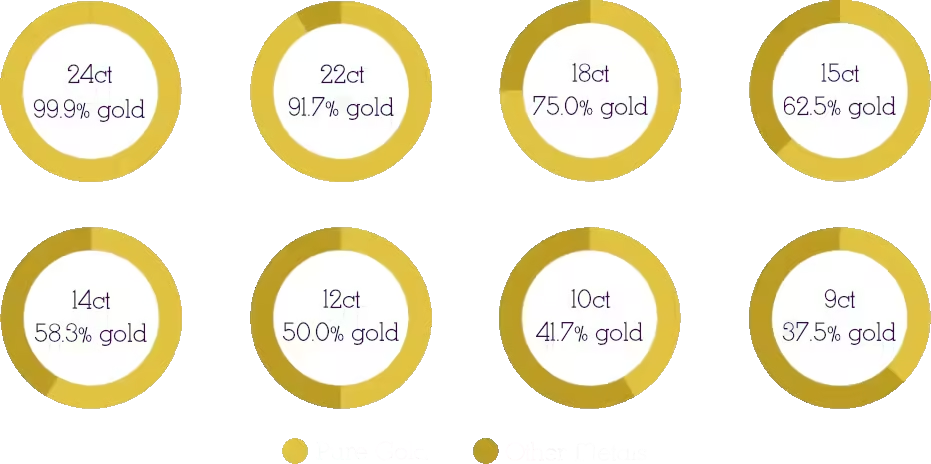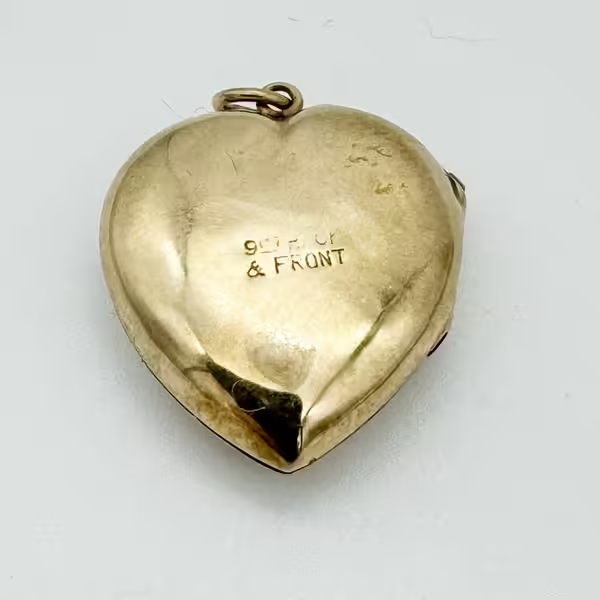One of the most common questions we get asked when looking at the Golden jewellery on our stall is “is it real Gold?”, and often with good reason.
There are some fantastic costume and plating methods that have been used historically to achieve a golden look while not making the item from solid gold. In this article we are going to explain the most common types you will see among our product range.
Solid Gold
As you probably expect the top end of the range of golden jewellery items are those made from a form of solid gold. Despite the naming, solid gold/real gold jewellery is actually made from a metal alloy containing gold. There are strict rules and laws around the marking and advertising these alloys, as the higher the gold content the higher the intrinsic value of the item. The gold content within an item is measured in Carats, which is defined as parts per 24.

As gold is a very soft metal there are some advantages to lower carat gold jewellery – a 9ct gold ring is far stronger and less likely to dent/chip than a 22ct gold ring for example. This can also affect why a historical jewellery may have chosen to work in a particular carat, such as 10ct or 12ct when making a more elaborate item.
Here in the UK an item must be assayed at 9ct or higher to be sold as a ‘Gold’ item.
Whilst we sometimes carry a limited selection of ‘solid’ gold items in stock, these are rare and will be marked on their price label with their carat.
Gold Fronted
This is a historical method for creating golden jewellery – particularly popular for lockets & brooches in the late Victorian and Edwardian eras.
These items feature a solid gold front (sometimes also a back), with a base metal such as jewellers brass or low grade silver used to create the ‘hidden’ parts of the jewellery.
Good examples would be on a locket using jewellers brass for the hinge and inner locket frame. This allows for a more robust item, that is also considerably more affordable that a ‘solid’ gold alternative.
These items can actually include a surprisingly high gold content, in the case of some lockets as much as 80% of the item can be made from ‘solid’ gold. Items that are gold fronted or gold front and backed will be marked as such, and usually include the carat rating of the gold areas. Examples would be ‘9ct front & back’ or ’12ct front’.

Rolled Gold a.k.a Gold Filled
This was a very popular technique for creating long lasting golden jewellery from the 1890’s through to the 1960’s. Rolled gold jewelry is actually created with a thick sheet of gold that is permanently bonded to a base metal. This creates a very strong and long lasting coating that was designed to last for 30 plus years. In fact many examples in our stock are over 100 years old and still look like new.

In both the USA and Australia there are laws around the use of the terms ‘Gold Filled’ and ‘Rolled Gold’ that require the item to have a total gold content of a least 5%, which would equate to a 1ct rating were that system applicable.
When looking at items you can see a variety of marks used to indicate this type of golden production including ‘Gold Filled’, ‘Rolled Gold’, ‘R.G.’, ‘GF’, ‘9ct Rolled Gold’, ’14ct Rolled Gold’, ’18ct RGP’.
Gold Vermeil
This is a very special type of gold-plated jewellery produced by adding an extra thick layer of gold to a sterling silver base item. These items are prized for their durability and for the guarantee of the quality metal below the plating.
Various countries have differing laws around the marking and retailing of Gold Vermeil. In the UK these items will follow the standard silver hallmarking laws, but may feature an indication of the gold carat value. An example we see often would be ‘9ct on’ and then the British silver hallmarks. Foreign examples can include both 925 and 9K or 18K marks.
Like all electroplated items the gold will gradually fade over time, but the remaining item will still be a beautiful silver item of jewellery.

Gold Plate/Electroplate
The most common and affordable form of creating golden jewellery, this is the process of adding a very thin layer of gold onto the outside of a completed item of jewellery.
The thickness of the gold plate is measured in ‘microns’, or 0.001 of a millimeter.

The lowest form of electroplated jewellery, including most modern made items can be as low as 0.5 micron thick, up to around 1 micron.
Older items, particularly those from the more well known designers, will often range from 2 to 3 microns of thickness.
Sadly it is very rare for these items to be marked with their thickness of plating, so we are left to judge the quality based on the level of survival of the plating over the years.
Golden Alloys
The final category of golden jewellery comes from items that are not plated or in fact made from gold in any form. These are made from metal alloys that are created to colour into a shade of gold colours.
Particularly common from the 1940’s to the 1970’s; many of the great costume jewellery designers developed their own no-fade alloys such as ‘Trifanium’ that was patented by Trifari in 1947

So in summary there have been a wide variety of ways used to achieve a golden finish to jewellery throughout history; all of which can be found within our stock. If you are uncertain about what the item you are buying, and where it falls on this list we will be very happy to tell you and to explain.